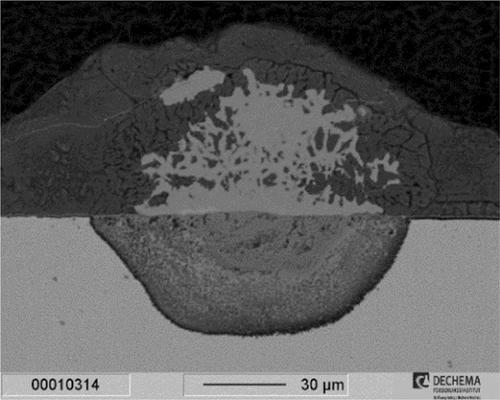当前位置:
X-MOL 学术
›
Mater. Corros.
›
论文详情
Our official English website, www.x-mol.net, welcomes your feedback! (Note: you will need to create a separate account there.)
The influence of iron and cobalt on the type II hot corrosion behavior of NiCr model alloys
Materials and Corrosion ( IF 1.8 ) Pub Date : 2020-04-19 , DOI: 10.1002/maco.201911376 Till König 1 , Xabier Montero 1 , Mathias Galetz 1
Materials and Corrosion ( IF 1.8 ) Pub Date : 2020-04-19 , DOI: 10.1002/maco.201911376 Till König 1 , Xabier Montero 1 , Mathias Galetz 1
Affiliation

|
The type II hot corrosion behavior of the alloys NiCr20, NiCr20Co10, and NiCr20Fe10 is investigated at 700°C in synthetic air + 0.5% SO2 for up to 300 hr. Pure Na2SO4 and a eutectic mixture of MgSO4–Na2SO4 are applied as deposits. The kinetics are investigated via dimensional metrology and correlated to the microstructural progression of the corrosion by examining the cross‐sections. All alloys exhibit two‐stage corrosion kinetics, with initially low and subsequently increased metal losses. Independent of the deposit composition, the metal loss after the longest exposure time is increased by the alloying element cobalt, whereas it is decreased for the iron‐containing alloy. All alloys show increased metal losses when exposed to the MgSO4–Na2SO4 deposit. The time to the propagation stage is similar for all tests. During the stage of low metal loss, all alloys develop a chromia scale and internal chromium sulfides. When the propagation stage is reached, chromium and nickel can be found along with oxygen and sulfur within the pit. Nickel is dissolved into the deposit, where it precipitates.
中文翻译:

铁和钴对NiCr模型合金II型热腐蚀行为的影响
NiCr20,NiCr20Co10和NiCr20Fe10合金的II型热腐蚀行为是在700℃,合成空气+ 0.5%SO 2中研究长达300个小时的。纯Na 2 SO 4和MgSO 4 -Na 2 SO 4的低共熔混合物用作存款。通过尺寸计量学研究动力学,并通过检查横截面将其与腐蚀的微观结构进行关联。所有合金都表现出两阶段的腐蚀动力学,最初的金属损耗低,随后增加。与合金成分无关,最长暴露时间后的金属损耗会因合金元素钴而增加,而含铁合金则降低。当暴露于MgSO 4 -Na 2 SO 4时,所有合金的金属损失均增加存款。所有测试到传播阶段的时间都是相似的。在低金属损失阶段,所有合金都会出现氧化铬鳞屑和内部硫化铬。当达到繁殖阶段时,在矿坑中会发现铬和镍以及氧和硫。镍溶解在沉积物中,并在那里沉淀。
更新日期:2020-04-19
中文翻译:

铁和钴对NiCr模型合金II型热腐蚀行为的影响
NiCr20,NiCr20Co10和NiCr20Fe10合金的II型热腐蚀行为是在700℃,合成空气+ 0.5%SO 2中研究长达300个小时的。纯Na 2 SO 4和MgSO 4 -Na 2 SO 4的低共熔混合物用作存款。通过尺寸计量学研究动力学,并通过检查横截面将其与腐蚀的微观结构进行关联。所有合金都表现出两阶段的腐蚀动力学,最初的金属损耗低,随后增加。与合金成分无关,最长暴露时间后的金属损耗会因合金元素钴而增加,而含铁合金则降低。当暴露于MgSO 4 -Na 2 SO 4时,所有合金的金属损失均增加存款。所有测试到传播阶段的时间都是相似的。在低金属损失阶段,所有合金都会出现氧化铬鳞屑和内部硫化铬。当达到繁殖阶段时,在矿坑中会发现铬和镍以及氧和硫。镍溶解在沉积物中,并在那里沉淀。



























 京公网安备 11010802027423号
京公网安备 11010802027423号